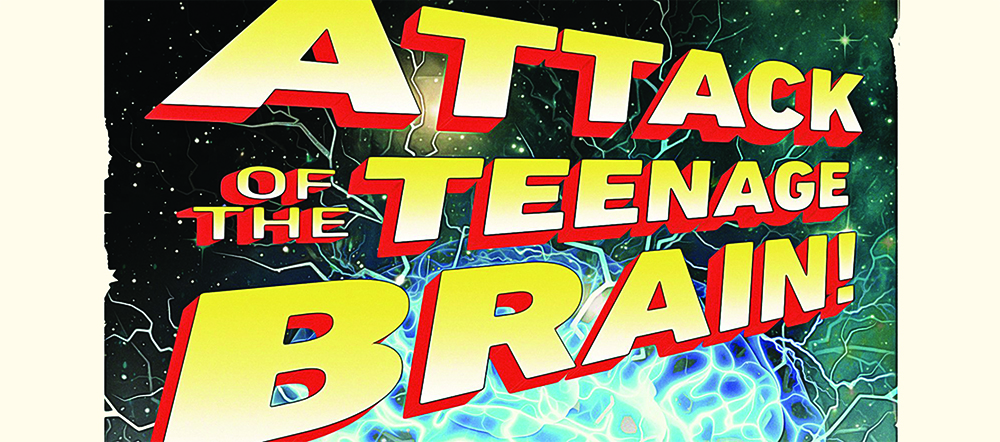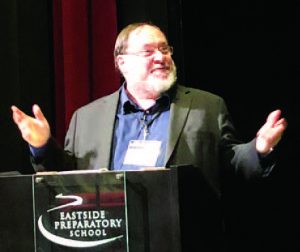
The Wacky & Wonderful Brains Of Teenager (And Those Who Teach Them)
By Dr. Elena Olsen, English Faculty

Dr. Medina presents to EPS faculty.
ON NOVEMBER 26 DURING THEIR PROGRAM Development Day, Eastside Prep faculty were treated to a visit from Dr. John Medina, author of Attack of the Teenage Brain: Understanding and Supporting the Weird and Wonderful Adolescent Learner. All faculty read Attack of the Teenage Brain over the summer, and have been discussing it periodically throughout the year. Medina, a developmental molecular biologist and Professor of Bioengineering at the University of Washington School of Medicine, spoke about the “attack of the teenage brain” and how to support its learning. Faculty had a chance to ask questions and engage in conversation with Medina about his ideas on adolescent brain functioning and his vision of the “school of the future.” Visits like these are a vital part of faculty professional development. Hearing from experts and scholars inspires teachers to reflect on and refine their practices. Dr. Medina in particular embodies some of the core pedagogical principles at Eastside Prep: interdisciplinarity (he is a scientist who also works in the psychology and education fields and is an eloquent writer); holistic thinking (examining how brain functioning intersects not only with behavior but with learning and growing); and humor (his lectures are never dull!).
During his November visit, Medina elaborated on the essential concepts and arguments in Attack of the Teenage Brain. The key to understanding and effectively engaging the teenage brain is, in Medina’s view, understanding executive function—and how it functions and does not function during adolescence. Executive function is what it sounds like—the functioning of our brain that allows us to get things done in an efficient, organized manner. Parents and teachers reading this article don’t need neuroscience to know that adolescents don’t always exhibit strong executive function. Indeed, adolescents are infamous for making choices and behaving in ways that seem to laugh in the face of the frontal lobe: You chose to watch TV for the past two hours instead of studying for the test you said you are so stressed about? You chose to eat half of that chocolate cake along with Coca-Cola and pizza, and now you’re complaining about a bellyache? There are many reasons for teenagers choosing risky behaviors or falling out of line. One reason Medina discussed is that we are actually hard-wired to take risks during our adolescence, especially when it comes to relationships with peers, because it is vital to the continuance of the species (in ensuring diversity in the gene pool, among other things).
During his November visit, Medina elaborated on the essential concepts and arguments in Attack of the Teenage Brain.
So how do teachers and parents best support and grow this risk-taking, unreliably-executive-functioning brain? We can teach and parent in ways that allow for the teenage brain to take risks and to be exploratory—striking a balance between granting greater independence and establishing firm expectations and boundaries. Parents and teachers can also allow teenagers to be physically mobile, to burn off some of their energy spikes, and thrive in a “green” environment. Why a green environment—and what is a green environment? Research shows that we process and learn better when we do so surrounded by the green band of the light spectrum. The hypothesis is that this is because, for most of the (relatively short) history of our species, we had to learn, think, and act outdoors, reacting to and being guided by the natural world and natural light. This is still our “home,” evolutionarily speaking. Medina cites research that shows that even a green-spectrum light bulb or a few plants in a room can have a positive effect on brain function. And plants can also help boost our immune system—another benefit in the germ-breeding grounds of schools.
Faculty began the school year in August by concentrating on how Medina’s research-based conclusions on adaptive parenting apply in the classroom.
How has Medina’s thinking about the “school of the future” impacted teaching at EPS? It is already evident in our classrooms and conversations—true to form, Eastside Prep faculty do not waste time discussing and acting on ideas they find compelling and effective. Indeed, faculty began the school year in August by concentrating on how Medina’s research-based conclusions on adaptive parenting apply in the classroom. Teachers are also integrating Medina’s work into specific aspects of classes. In Undercover Economics, Matt Delaney began constructing concept and term banks on the white board before formal discussions. He says, “The goal was to activate prior knowledge and take concepts/terms out of working memory. The hope is that with more working memory available, the students have more capacity for emotional regulation and cognitive flexibility during discussions. Conversations seemed to flow well, with students using visual access to terms to enhance the dialogue.” In Biology, Kip Wassink is going to help students adapt some of Medina’s ideas to experimentation.
Finally, Medina’s work reinforces much of what Eastside Prep curriculum and teachers already do—collaborative, inquiry-based learning, and active classrooms. Nickie Wallace and Amis Balcomb speak of how Medina’s visit reminded them of the importance of what they already do in the classroom—and sparked deeper inspiration for future possibilities in, for example, outdoor and experiential education. Balcomb envisions “plant lights and sustainable plants in stairwells and soothing forest sounds.” Others of us imagine a satellite campus for Eastside Prep on which academic and experiential learning could be even more integrated, and more “green.” Certainly, the expanding Outdoor Program and club at Eastside Prep, as well as outdoor experiences available during EBC Week, are vital opportunities for students to refresh and activate their best brains—and to take some safe, supervised, educational risks.
Indeed, John Medina’s work affirms the hundreds of things Eastside Prep faculty do every day to support students’ learning and well-being: conferring with colleagues about the best way to scaffold a project assignment or about how to best support a particular student; communicating as an advisory team on what a grade level most needs in social-emotional support; working with individual students on any and all aspects of assigned classwork; supporting students when they make mistakes, or fall short of expectations, or experience any other of those “attacks” of the teenage brain. Teachers know that this “teenage brain” is robustly adaptive, flexible, and brilliant—and, crazy though we seem to others, we feel lucky to spend our days with these wild and wacky and brainy adolescents.
Faculty began the school year in August by concentrating on how Medina’s research-based conclusions on adaptive parenting apply in the classroom.

